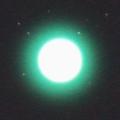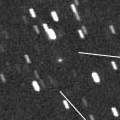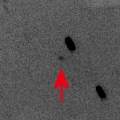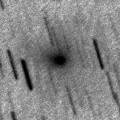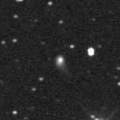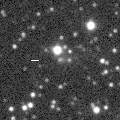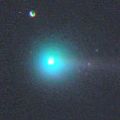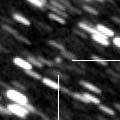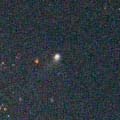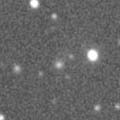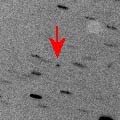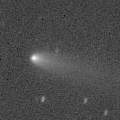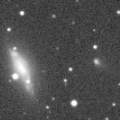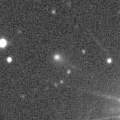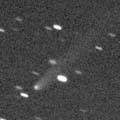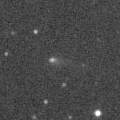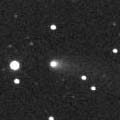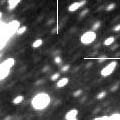Weekly Information about Bright Comets (2008 Jan. 19: North)
|
Japanese version Home page |
Updated on January 27, 2008 |
|||
|
||||
| Best time and the azimuth, altitude (A,h) are at lat. 35 deg in the Northern Hemisphere. |
![]()
|
|
|
Now it is bright as 12.6 mag and visible visually (Dec. 30, Marco Goiato), brightening well as expected. It will reach to 11 mag in spring. It will keep bright for a long time, however, it keeps moving in the southern sky for a while after this. In the Northern Hemisphere, it keeps extremely low and hard to observe for a while. However, it will be getting higher after March, and will be visible visually at 11 mag in the evening sky until June. Then it becomes unobservable again. But it will appear in the morning sky again at 13 mag at the end of 2008, then it keeps bright and observable for a while. Date(TT) R.A. (2000) Decl. Delta r Elong. m1 Best Time(A, h) Jan. 19 9 51.28 -51 28.6 2.863 3.245 104 12.2 2:01 ( 0, 3) Jan. 26 9 48.92 -51 41.2 2.776 3.209 107 12.1 1:31 ( 0, 3) |
 (3200) Phaethon
(3200) Phaethon
|
|
It passed very near by the Earth in early December, and became bright as 12.6 mag (Dec. 5, Juan Jose Gonzalez). The very fast motion was easily observed in the excellent condition. However, it became unobservable in mid December. It will be extremely low in the evening at 16-17 mag in February. But actually, it will never be observable again in this apparition. Date(TT) R.A. (2000) Decl. Delta r Elong. m1 Best Time(A, h) Jan. 19 20 9.29 -16 41.4 1.222 0.252 4 12.6 18:42 ( 80,-14) Jan. 26 21 7.70 -9 1.8 1.346 0.450 13 14.5 18:49 ( 83, -5) |
 29P/Schwassmann-Wachmann 1
29P/Schwassmann-Wachmann 1
 C/2006 OF2 ( Broughton )
C/2006 OF2 ( Broughton )
 C/2006 S5 ( Hill )
C/2006 S5 ( Hill )
 C/2008 A1 ( McNaught )
C/2008 A1 ( McNaught )
|
|
New bright comet. It is already visible visually at 14.0 mag (Jan. 12, Alan Hale). It is expected to be 7 mag in September. But it keeps moving in the southern sky, so it is difficult to see in the Northern Hemisphere. It will be locating in the very low sky at about 10 degree high until mid March, then it becomes unobservable in the Northern Hemisphere. It will appear in the evening sky at 7 mag in late September, but it keeps locating in the evening low sky until the end of 2008 when it fades out down to 10 mag. Then it turns to appear in the morning sky, and it keeps observable in the northern sky after that while fading gradually. In the Southern Hemisphere, it keeps observable until late October after this. Date(TT) R.A. (2000) Decl. Delta r Elong. m1 Best Time(A, h) Jan. 19 6 20.99 -44 22.4 3.145 3.619 111 14.1 22:26 ( 0, 11) Jan. 26 6 8.96 -44 33.4 3.102 3.543 108 14.0 21:47 ( 0, 10) |
 93P/Lovas 1
93P/Lovas 1
 C/2007 F1 ( LONEOS )
C/2007 F1 ( LONEOS )
 192P/2007 T3 ( Shoemaker-Levy 1 )
192P/2007 T3 ( Shoemaker-Levy 1 )
|
|
It was faint as 18 mag in October, but it brightened rapidly after that. Now it is bright as 13.4 mag and visible visually (Jan. 4, Seiichi Yoshida). It has already passed the perihelion. But it will be brightest after the perihelion passage. It will be visible at 14 mag until February. But the altitude will be around 30 deg. Then it is observable until April when it becomes too low at 17 mag. Date(TT) R.A. (2000) Decl. Delta r Elong. m1 Best Time(A, h) Jan. 19 23 58.94 -8 57.3 1.779 1.516 58 14.5 18:42 ( 48, 33) Jan. 26 0 17.37 -5 6.6 1.840 1.541 56 14.5 18:49 ( 54, 34) |
 C/2006 U6 ( Spacewatch )
C/2006 U6 ( Spacewatch )
 C/2007 B2 ( Skiff )
C/2007 B2 ( Skiff )
|
|
Now it is 14.3 mag, already visible visually (Jan. 19, Alan Hale). It will reach to 13.5 mag from March to July. It keeps observable in good condition for a long time until May. Date(TT) R.A. (2000) Decl. Delta r Elong. m1 Best Time(A, h) Jan. 19 12 48.25 8 40.0 3.185 3.641 109 14.8 4:58 ( 0, 64) Jan. 26 12 49.88 8 13.4 3.056 3.603 116 14.7 4:32 ( 0, 63) |
 C/2007 G1 ( LINEAR )
C/2007 G1 ( LINEAR )
 C/2006 K4 ( NEAT )
C/2006 K4 ( NEAT )
 C/2005 L3 ( McNaught )
C/2005 L3 ( McNaught )
 C/2006 V1 ( Catalina )
C/2006 V1 ( Catalina )
 110P/Hartley 3
110P/Hartley 3
 19P/Borrelly
19P/Borrelly
|
|
It will reach to 11 mag in 2008 summer. It must have already brightened up to 15 mag, but the comet was not observed recently. The condition in this apparition is bad. In the Southern Hemisphere, it keeps extremely low, or under the horizon, so it will not be observable. In the Northern Hemisphere, it is not observable until August when it appears in the morning sky at 11 mag. After August, it keeps observable and fading in the morning sky. Date(TT) R.A. (2000) Decl. Delta r Elong. m1 Best Time(A, h) Jan. 19 22 2.93 -35 4.9 3.160 2.365 30 15.5 18:42 ( 50, -4) Jan. 26 22 17.40 -33 40.6 3.137 2.315 27 15.3 18:49 ( 53, -7) |
 C/2006 W3 ( Christensen )
C/2006 W3 ( Christensen )
 C/2003 T12 ( SOHO )
C/2003 T12 ( SOHO )
|
|
The return of a comet discovered in 2003 by SOHO spacecraft. It can be a short periodic comet with a period of about 4 years. If so, it is expected to return in 2008 spring. If it passes the perihelion in spring, it will be visible at 12-15 mag in the evening sky. But the period is quite uncertain with an error of several months. So we have to wait until it is re-discovered by chance. Date(TT) R.A. (2000) Decl. Delta r Elong. m1 Best Time(A, h) Jan. 19 20 4.24 -15 33.4 1.845 0.869 5 16.4 18:42 ( 81,-15) Jan. 26 20 37.57 -14 46.1 1.738 0.760 4 15.4 18:49 ( 82,-14) |
 C/2007 W1 ( Boattini )
C/2007 W1 ( Boattini )
|
|
Now it is brightening up to 16.2 mag (Jan. 14, Ken-ichi Kadota). It will pass 0.85 A.U. from the sun in late June in 2008, and it is expected to reach to 6 mag. In the Northern Hemipshere, it keeps observable in good condition for a long time after this, while the comet is brightening gradually. The comet will be 14 mag in February and become visible visually. Then it is observable until around May 25, when the comet will be 7.5 mag. It will be unobservable for one and a half month around the perihelion passage. But it will appear in the morning sky again at 7 mag in early July, then it keeps observable after that while the comet is fading gradually. In the Southern Hemipsphere, it keeps observable all the period until the comet fades out, although it will be low in mid June. Date(TT) R.A. (2000) Decl. Delta r Elong. m1 Best Time(A, h) Jan. 19 12 36.19 -7 27.4 2.165 2.625 106 15.9 4:46 ( 0, 48) Jan. 26 12 40.22 -8 22.6 1.990 2.538 112 15.5 4:22 ( 0, 47) |
 2005 WY3
2005 WY3
|
|
Peculiar asteroid moving on a cometary orbit. It brightened up to 16.9 mag on Nov. 20 (Siding Spring Survey), but still completely asteroidal. It will reach to 15 mag in February and March. In the Northern Hemisphere, it keeps observable until July when it becomes fainter than 18 mag. It may show a cometary activity after this, although the perihelion distance is somewhat large as 1.8 A.U. Date(TT) R.A. (2000) Decl. Delta r Elong. m1 Best Time(A, h) Jan. 19 10 6.01 -32 13.7 1.082 1.784 119 15.7 2:16 ( 0, 23) Jan. 26 10 9.74 -32 1.5 1.037 1.783 123 15.6 1:52 ( 0, 23) |
 P/2007 H1 ( McNaught )
P/2007 H1 ( McNaught )
 26P/Grigg-Skjellerup
26P/Grigg-Skjellerup
|
|
It was so faint as 18 mag still in mid January. However, it must be brightening rapidly. It is expected to reach to 13 mag in March and April, and to be visible visually. It keeps observable in good condition for a long time in the Southern Hemisphere. In the Northern Hemisphre, it keeps locating low until March. But it will be getting higher after April and observable while the comet is fading. Date(TT) R.A. (2000) Decl. Delta r Elong. m1 Best Time(A, h) Jan. 19 12 40.66 -36 7.9 0.917 1.380 93 16.2 4:50 ( 0, 19) Jan. 26 13 10.19 -38 23.5 0.848 1.333 93 15.9 4:51 ( 0, 17) |
 50P/Arend
50P/Arend
 70P/Kojima
70P/Kojima
|
|
Now it is 16.8 mag (Nov. 23, Ken-ichi Kadota), brightening as expected. It keeps observable at 16.5 mag in good condition for a long time until April. Date(TT) R.A. (2000) Decl. Delta r Elong. m1 Best Time(A, h) Jan. 19 12 37.57 2 32.5 1.634 2.182 110 16.3 4:47 ( 0, 57) Jan. 26 12 42.16 2 38.9 1.581 2.203 116 16.3 4:24 ( 0, 58) |
 C/2006 K1 ( McNaught )
C/2006 K1 ( McNaught )
|
|
Now it is 16.2 mag (Nov. 24, Ken-ichi Kadota). It keeps observable in the evening sky until March. Date(TT) R.A. (2000) Decl. Delta r Elong. m1 Best Time(A, h) Jan. 19 2 48.67 -15 58.8 4.477 4.668 95 16.4 18:56 ( 0, 39) Jan. 26 2 49.35 -14 25.7 4.588 4.687 89 16.5 18:49 ( 6, 40) |
 74P/Smirnova-Chernykh
74P/Smirnova-Chernykh
|
|
It will reach to 15 mag in 2009 and 2010. Now it is 16.5 mag (Dec. 18, J. R. Vidal). It will be observable at 16.5 mag in good condition until March. Date(TT) R.A. (2000) Decl. Delta r Elong. m1 Best Time(A, h) Jan. 19 4 47.62 23 18.6 3.231 3.990 135 16.6 20:54 ( 0, 78) Jan. 26 4 45.79 23 21.5 3.302 3.982 127 16.6 20:25 ( 0, 78) |
 188P/2007 J7 ( LINEAR-Mueller )
188P/2007 J7 ( LINEAR-Mueller )
 C/2007 U1 ( LINEAR )
C/2007 U1 ( LINEAR )
|
|
It will reach to 15.5 mag in 2008 autumn and will be observable in good condition. In this winter, it is observable at 17 mag in good condition until March. Date(TT) R.A. (2000) Decl. Delta r Elong. m1 Best Time(A, h) Jan. 19 5 19.43 4 50.5 3.034 3.820 137 16.7 21:25 ( 0, 60) Jan. 26 5 6.42 5 33.0 3.097 3.789 128 16.7 20:45 ( 0, 61) |
 C/2003 WT42 ( LINEAR )
C/2003 WT42 ( LINEAR )
 124P/Mrkos
124P/Mrkos
|
|
Now it is 18.0 mag (Jan. 7, Ken-ichi Kadota). It will reach to 16 mag from February to April, and will be observable in good condition. Date(TT) R.A. (2000) Decl. Delta r Elong. m1 Best Time(A, h) Jan. 19 11 34.36 60 17.7 1.016 1.778 125 17.1 3:44 (180, 65) Jan. 26 11 28.86 60 56.9 0.956 1.741 127 16.9 3:11 (180, 64) |
 65P/Gunn
65P/Gunn
|
|
It will reach to 13 mag in 2010. Now it is around the aphelion, but it is observable at 17 mag in good condition. Date(TT) R.A. (2000) Decl. Delta r Elong. m1 Best Time(A, h) Jan. 19 8 45.37 29 34.7 3.312 4.275 166 17.0 0:56 ( 0, 85) Jan. 26 8 40.01 30 1.6 3.291 4.261 168 16.9 0:23 ( 0, 85) |
 191P/2007 N1 ( McNaught )
191P/2007 N1 ( McNaught )
 180P/2006 U3 ( NEAT )
180P/2006 U3 ( NEAT )
|
|
Now it is 18.3 mag (Dec. 14, Ken-ichi Kadota). It will be observable in good condition for a hile until spring. It will reach to 16.5 mag in March. Date(TT) R.A. (2000) Decl. Delta r Elong. m1 Best Time(A, h) Jan. 19 11 3.67 28 58.5 1.790 2.605 137 17.1 3:13 ( 0, 84) Jan. 26 11 3.50 30 10.1 1.732 2.591 143 17.0 2:46 ( 0, 85) |
 P/2007 T6 ( Catalina )
P/2007 T6 ( Catalina )
|
|
It will be observable at 17 mag in good condition until February. Date(TT) R.A. (2000) Decl. Delta r Elong. m1 Best Time(A, h) Jan. 19 9 22.37 31 36.2 1.599 2.541 158 17.1 1:33 ( 0, 86) Jan. 26 9 17.56 33 7.1 1.612 2.567 162 17.1 1:00 ( 0, 88) |
 C/2007 M2 ( Catalina )
C/2007 M2 ( Catalina )
|
|
It keeps 16 mag for one year from 2008 spring to 2009 spring. In the Northern Hemisphere, it keeps observable in good condition while the comet is brightening until 2008 spring. But the comet moves southwards after that, and it will never observable after 2008 July. Date(TT) R.A. (2000) Decl. Delta r Elong. m1 Best Time(A, h) Jan. 19 12 52.87 13 28.3 4.136 4.573 110 17.2 5:02 ( 0, 68) Jan. 26 12 50.07 13 13.2 3.993 4.535 117 17.1 4:32 ( 0, 68) |
 C/2007 T5 ( Gibbs )
C/2007 T5 ( Gibbs )
|
|
It will be observable at 17.5 mag in good condition until May. Date(TT) R.A. (2000) Decl. Delta r Elong. m1 Best Time(A, h) Jan. 19 8 21.32 32 34.7 3.213 4.178 167 17.2 0:32 ( 0, 87) Jan. 26 8 17.03 33 49.6 3.206 4.164 164 17.2 0:00 ( 0, 89) |
 117P/Helin-Roman-Alu 1
117P/Helin-Roman-Alu 1
 C/2002 VQ94 ( LINEAR )
C/2002 VQ94 ( LINEAR )
 C/2007 D1 ( LINEAR )
C/2007 D1 ( LINEAR )
 C/2006 M1 ( LINEAR )
C/2006 M1 ( LINEAR )
 C/2007 Y1 ( LINEAR )
C/2007 Y1 ( LINEAR )
|
|
It will be observable at 17.5-18 mag until March. Date(TT) R.A. (2000) Decl. Delta r Elong. m1 Best Time(A, h) Jan. 19 9 30.05 -7 16.4 2.539 3.389 144 17.8 1:41 ( 0, 48) Jan. 26 9 19.41 -4 45.0 2.469 3.379 153 17.8 1:02 ( 0, 50) |
 173P/2005 T1 ( Mueller 5 )
173P/2005 T1 ( Mueller 5 )
 128P/Shoemaker-Holt 1
128P/Shoemaker-Holt 1
|
|
Now it is 18.6 mag (Nov. 16, Ken-ichi Kadota). In the previous apparition in 1997, it brightened after the perihelion passage, and observed visually at 13 mag. However, such a brightening did not happen and the comet kept faint in the current apparition. It became fainter by 3-4 mag than the previous apparition. Date(TT) R.A. (2000) Decl. Delta r Elong. m1 Best Time(A, h) Jan. 19 7 2.00 16 42.5 2.331 3.293 165 18.8 23:08 ( 0, 72) Jan. 26 6 57.72 16 51.8 2.374 3.307 157 18.9 22:36 ( 0, 72) |
![]()
